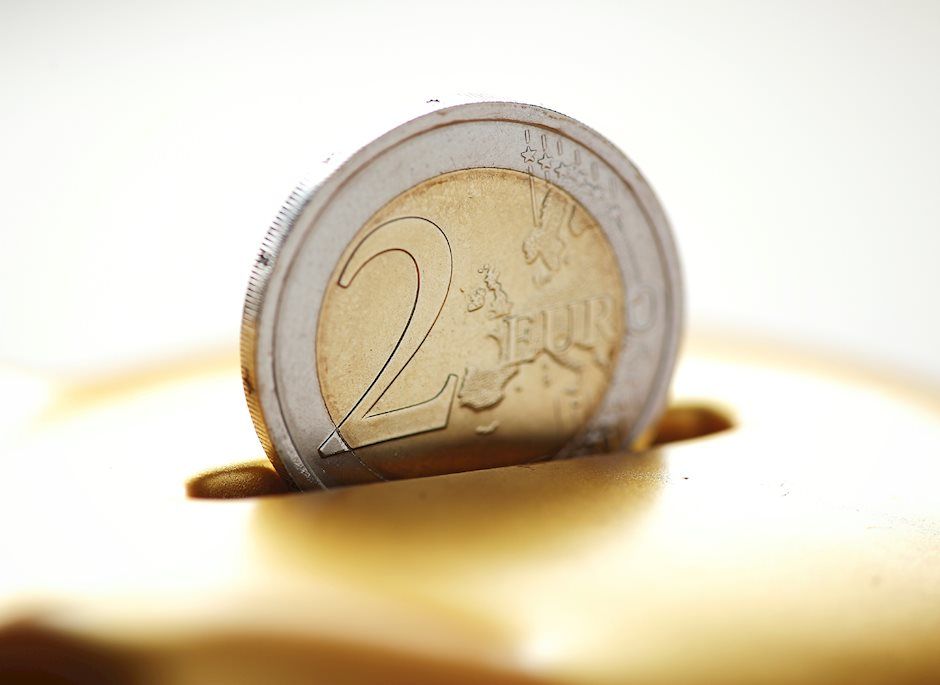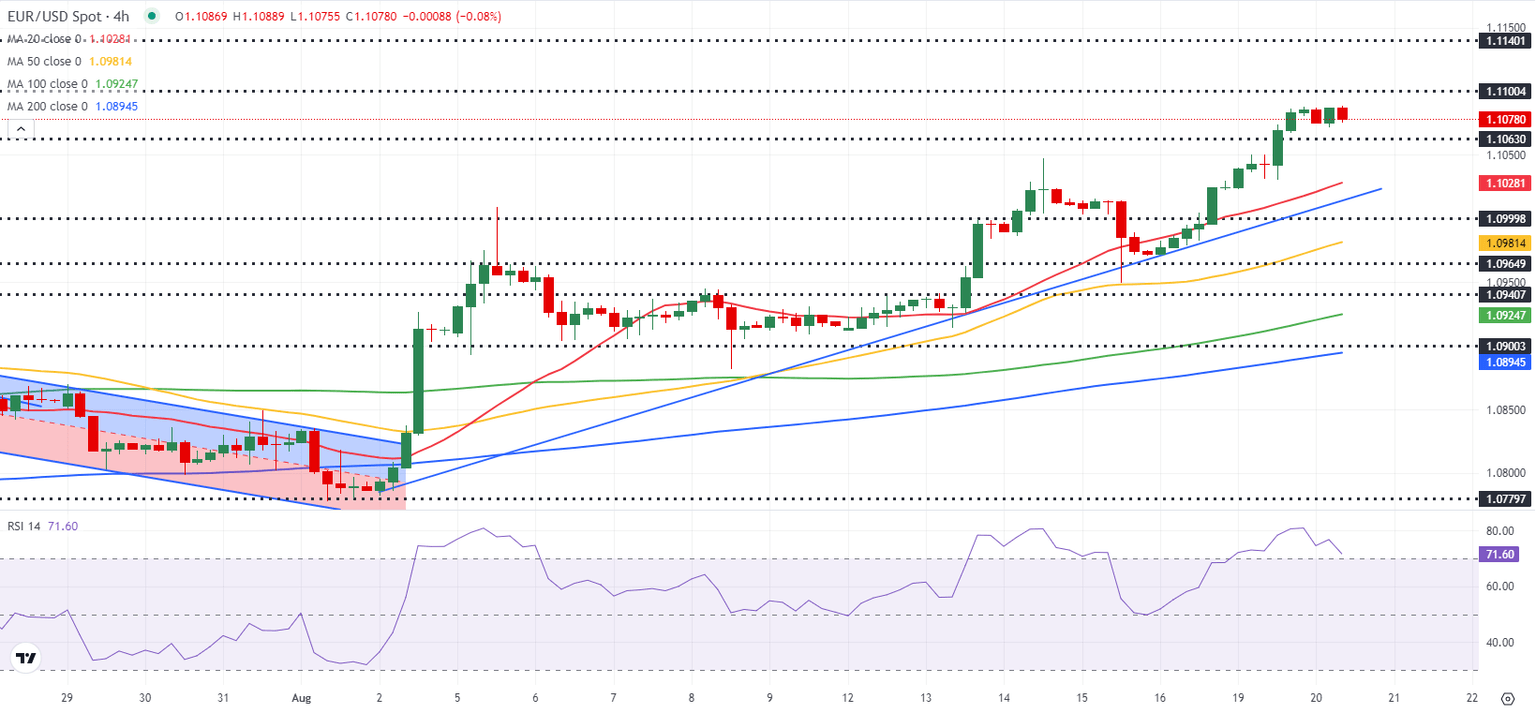EUR/USD Forecast: Euro could remain bullish if risk flows continue to dominate markets
- EUR/USD trades in a tight channel below 1.1100 on Tuesday.
- The pair could correct lower if 1.1060 support fails.
- The risk perception is likely to drive the USD's valuation in the absence of high-tier data releases.

EUR/USD started the new week on a firm footing and gained 0.5% for the second consecutive trading day on Monday. After touching its highest level since December near 1.1090 early Tuesday, the pair retreated slightly and was last seen trading below 1.1080.
Euro PRICE This week
The table below shows the percentage change of Euro (EUR) against listed major currencies this week. Euro was the strongest against the US Dollar.
| USD | EUR | GBP | JPY | CAD | AUD | NZD | CHF | |
|---|---|---|---|---|---|---|---|---|
| USD | -0.49% | -0.49% | -0.88% | -0.50% | -0.92% | -1.49% | -0.65% | |
| EUR | 0.49% | -0.08% | -0.34% | -0.00% | -0.52% | -1.17% | -0.19% | |
| GBP | 0.49% | 0.08% | -0.44% | 0.04% | -0.45% | -1.03% | -0.11% | |
| JPY | 0.88% | 0.34% | 0.44% | 0.31% | -0.08% | -0.50% | 0.09% | |
| CAD | 0.50% | 0.00% | -0.04% | -0.31% | -0.45% | -0.92% | -0.19% | |
| AUD | 0.92% | 0.52% | 0.45% | 0.08% | 0.45% | -0.50% | 0.34% | |
| NZD | 1.49% | 1.17% | 1.03% | 0.50% | 0.92% | 0.50% | 0.88% | |
| CHF | 0.65% | 0.19% | 0.11% | -0.09% | 0.19% | -0.34% | -0.88% |
The heat map shows percentage changes of major currencies against each other. The base currency is picked from the left column, while the quote currency is picked from the top row. For example, if you pick the Euro from the left column and move along the horizontal line to the US Dollar, the percentage change displayed in the box will represent EUR (base)/USD (quote).
The upbeat risk mood didn't allow the US Dollar (USD) to stay resilient against its major rivals on Monday and opened the door for another leg higher in EUR/USD. Meanwhile, dovish comments from Federal Reserve (Fed) Bank of Minneapolis President Neel Kashkari put additional weight on the USD.
"The balance of risks has shifted more towards labor market and away from inflation side of our dual mandate," Kashkari told the Wall Street Journal and said it will be appropriate to debate a rate cut at the September meeting.
Eurostat confirmed the Harmonized Index of Consumer Prices rose 2.6% on a yearly basis in July, matching the initial estimate and the market expectation.
The economic calendar will not offer any high-impact data releases on Tuesday. Although there are several Fed policymakers scheduled to speak later in the day, they are unlikely to touch on the monetary policy outlook. Hence, investors could react to changes in risk perception. A continuation of the risk rally is likely to hurt the USD and allow EUR/USD to stretch higher.
EUR/USD Technical Analysis
The Relative Strength Index edges lower toward 70 after touching 80 on Monday, suggesting that the pair stages a technical correction, while maintaining the bullish stance in the near-term outlook.
1.1060 (static level, former resistance) aligns as first support before 1.1030 (ascending trend line) and 1.1000 (psychological level, static level).
On the upside, first resistance is located at 1.1100 (psychological level, static level) ahead of 1.1140 (December 28, 2023, high).
Euro FAQs
The Euro is the currency for the 20 European Union countries that belong to the Eurozone. It is the second most heavily traded currency in the world behind the US Dollar. In 2022, it accounted for 31% of all foreign exchange transactions, with an average daily turnover of over $2.2 trillion a day. EUR/USD is the most heavily traded currency pair in the world, accounting for an estimated 30% off all transactions, followed by EUR/JPY (4%), EUR/GBP (3%) and EUR/AUD (2%).
The European Central Bank (ECB) in Frankfurt, Germany, is the reserve bank for the Eurozone. The ECB sets interest rates and manages monetary policy. The ECB’s primary mandate is to maintain price stability, which means either controlling inflation or stimulating growth. Its primary tool is the raising or lowering of interest rates. Relatively high interest rates – or the expectation of higher rates – will usually benefit the Euro and vice versa. The ECB Governing Council makes monetary policy decisions at meetings held eight times a year. Decisions are made by heads of the Eurozone national banks and six permanent members, including the President of the ECB, Christine Lagarde.
Eurozone inflation data, measured by the Harmonized Index of Consumer Prices (HICP), is an important econometric for the Euro. If inflation rises more than expected, especially if above the ECB’s 2% target, it obliges the ECB to raise interest rates to bring it back under control. Relatively high interest rates compared to its counterparts will usually benefit the Euro, as it makes the region more attractive as a place for global investors to park their money.
Data releases gauge the health of the economy and can impact on the Euro. Indicators such as GDP, Manufacturing and Services PMIs, employment, and consumer sentiment surveys can all influence the direction of the single currency. A strong economy is good for the Euro. Not only does it attract more foreign investment but it may encourage the ECB to put up interest rates, which will directly strengthen the Euro. Otherwise, if economic data is weak, the Euro is likely to fall. Economic data for the four largest economies in the euro area (Germany, France, Italy and Spain) are especially significant, as they account for 75% of the Eurozone’s economy.
Another significant data release for the Euro is the Trade Balance. This indicator measures the difference between what a country earns from its exports and what it spends on imports over a given period. If a country produces highly sought after exports then its currency will gain in value purely from the extra demand created from foreign buyers seeking to purchase these goods. Therefore, a positive net Trade Balance strengthens a currency and vice versa for a negative balance.
Premium
You have reached your limit of 3 free articles for this month.
Start your subscription and get access to all our original articles.
Author

Eren Sengezer
FXStreet
As an economist at heart, Eren Sengezer specializes in the assessment of the short-term and long-term impacts of macroeconomic data, central bank policies and political developments on financial assets.


















